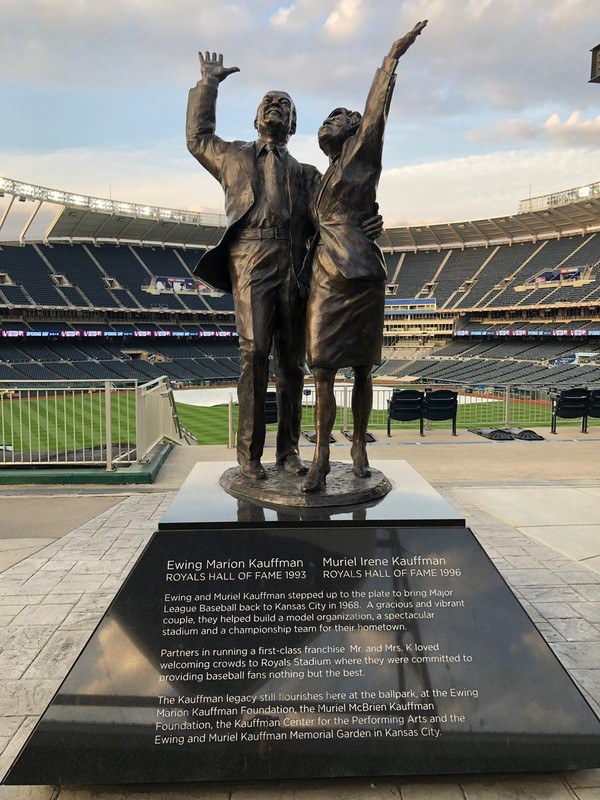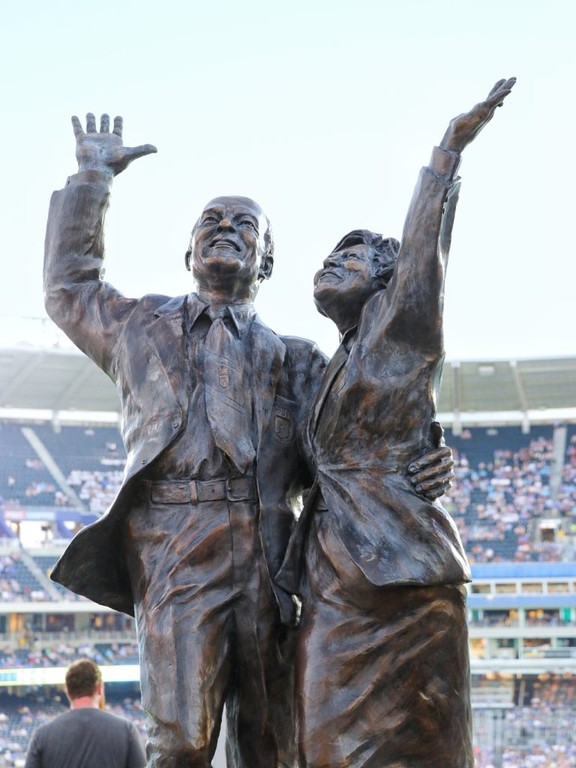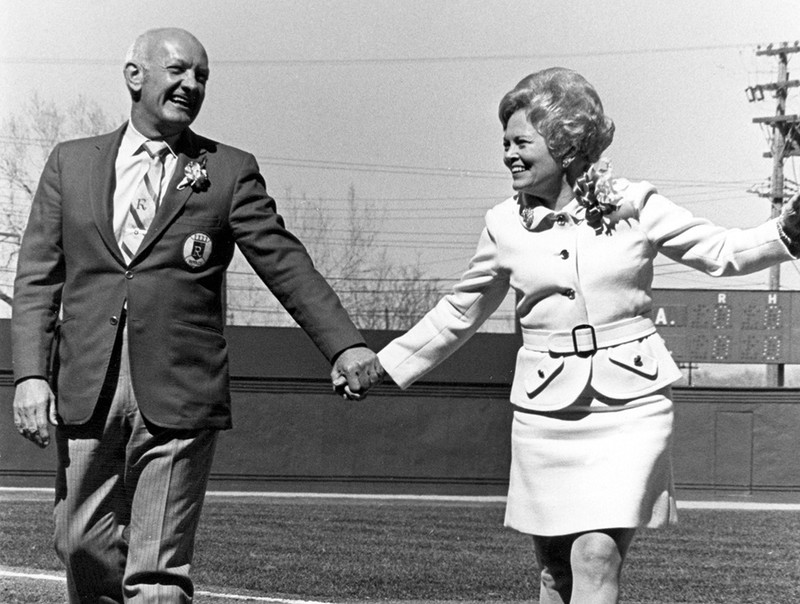Statue of Ewing and Muriel Kauffman
Introduction
Text-to-speech Audio
This statue commemorates former Kansas City Royals owner, Ewing Kauffman (1916-1993), and his wife, Muriel (1916-1995). A Missouri native and World War II veteran, Ewing Kauffman used his own savings to found Marion Laboratories in 1950. Beginning in the basement of his home in Kansas City, the pharmaceutical company steadily grew into an industry leader. In February 1962, Kauffman married Muriel McBrien, a Canadian-born widow and daughter of a Tory politician. Encouraged by his wife, he submitted a bid for the Major League Baseball expansion franchise in Kansas City, and the league awarded it to him in 1968. Named after the American Royal, a livestock show held each year in the city, the Kansas City Royals began play the following year at Municipal Stadium, later moving to brand-new Royals Stadium in 1973. Under Kauffman’s ownership, the franchise earned six division titles and two American League pennants. In 1985, it reached the pinnacle of Major League Baseball when it defeated the St. Louis Cardinals in seven games to clinch its first World Series title. Eight years later, Kauffman died from bone cancer at the age of seventy-six. Muriel Kauffman passed away in 1995 at the age of seventy-eight. On August 21, 2009, prior to their game against the Minnesota Twins, the Royals unveiled a statue of the Kauffmans in Kauffman Stadium’s new left centerfield concourse. Designed by world-renowned artist Harry Weber, who also created the statues of former Royals second baseman Frank White and the club’s former manager Dick Howser, the larger-than-life-sized bronze sculpture depicts the couple dressed in their Sunday best. With beaming smiles on their faces, they look up and wave to grateful Royals fans.
Images
Statue of Ewing and Muriel Kauffman in Kauffman Stadium’s new left centerfield concourse

A closer look at the bronze sculpture

Ewing (1916-1993) and Muriel (1916-1995) Kauffman

Backstory and Context
Text-to-speech Audio
Ewing Marion Kauffman was born on his family’s farm on September 21, 1916 near Garden City, Missouri. His father was a farmer of German ancestry. His mother was a schoolteacher. When Kauffman was still young, his father gave up farming and moved the family to Kansas City after flooding destroyed his crops in three consecutive years and an accident robbed him of sight in one eye. There, his father struggled selling insurance, while his mother took in boarders. With his family eking out an existence, the young Kauffman sold eggs from his grandparents’ farm to supplement the family’s income, an early foray into sales that would pay dividends in the future. Later, he attended the city’s Westport High School, where he played on the school’s football team. After graduating from high school in 1934, Kauffman briefly rode the rails and hitchhiked across the country before returning home and earning an associate’s degree in business from the Junior College of Kansas City two years later. In December 1941, he married Marguerite Blackshire, whom he met at Sunday school. About a month later, as the country mobilized for war, Kauffman joined the U.S. Navy, eventually becoming a signalman. In his leisure time, he plays cards with his fellow sailors, winning nearly $100,000 over the course of a few years. Kauffman later used some of the money to start the business that would transform him into a billionaire later in life.
After returning home from the war, Kauffman took a job as a salesman for Lincoln Laboratories, a pharmaceutical company headquartered in Decatur, Illinois. Demonstrating a knack for sales, he quickly became the company’s most successful salesman. Believing Kauffman to be making too much money for his position, the company “rewarded” him by reducing his commission rate and shrinking his sales territory. Consequently, he decided to resign and start his own business. In 1950, with his own savings, Kauffman launched Marion Laboratories. Beginning in the basement of his home in Kansas City, the pharmaceutical company steadily grew into an industry leader, transforming Kauffman into an immensely wealthy man. In 1987, Forbes Magazine listed his net worth to be approximately $470 million. Two years later, when Marion Laboratories merged with Merrell Dow Pharmaceuticals and Kauffman surrendered control of the company that he built from the ground up over nearly four decades, his stock was worth roughly $1.3 billion.
While he grew his pharmaceutical company, Kauffman experienced extreme highs and lows in his personal life. In December 1960, just over a week before Christmas, his wife died unexpectedly. To cope with his grief, Kauffman threw himself into his work. The following year, while in Miami for a convention, he met a Canadian-born widow named Muriel McBrien. The daughter of a Tory politician, she was also a graduate of McMaster University who then attended Osgoode Hall Law School. The two hit it off in Miami and eventually married in February 1962.
Committed to using his wealth for good and desirous of giving back to the city that gave him so much, Kauffman established the Ewing Marion Kauffman Foundation in 1966 to fund philanthropic endeavors in Kansas City. One such enterprise was Project STAR, a drug prevention program that taught youngsters about the dangers of drugs and peer pressure. Additionally, Kauffman allowed the American Heart Association and the American Red Cross to conduct CPR classes at Royals Stadium, which resulted in thousands of people learning the life-saving maneuver.
Following the 1967 season, Charles O. Finley, the owner of the Kansas City Athletics, moved the club to Oakland, California. Such demand for a big league team existed in Kansas City that Major League Baseball almost immediately granted the city an expansion franchise. Encouraged by his wife, Kauffman submitted a bid for the club, and the league awarded it to him in 1968. Named after the American Royal, a livestock show held each year in the city, the Kansas City Royals began play the following year at Municipal Stadium, later moving to brand-new Royals Stadium in 1973. Under Kauffman’s ownership, the franchise earned six division titles and two American League pennants. In 1985, it reached the pinnacle of Major League Baseball when it defeated the St. Louis Cardinals in seven games to clinch its first World Series title. Eight years later, Kauffman died from bone cancer at the age of seventy-six. Muriel Kauffman passed away in 1995 at the age of seventy-eight.
On August 21, 2009, prior to their game against the Minnesota Twins, the Royals unveiled a statue of the Kauffmans in Kauffman Stadium’s new left centerfield concourse. Designed by world-renowned artist Harry Weber, who also created the statues of former Royals second baseman Frank White and the club’s former manager Dick Howser, the larger-than-life-sized bronze sculpture depicts the couple dressed in their Sunday best. With beaming smiles on their faces, they look up and wave to grateful Royals fans.
Sources
"Ewing, 1916 to 1945." kauffman.org. Ewing Marion Kauffman Foundation. Web. 12 August 2021 <https://www.kauffman.org/emk/ewing/>.
"Ewing and Muriel Kauffman." harryweber.com. Harry Weber Official Website. Web. 12 August 2021 <http://harryweber.com>.
"Ewing Kauffman." mlb.com. The Royals Hall of Fame. Web. 12 August 2021 <https://www.mlb.com/royals/hall-of-fame/members/ewing-kauffman>.
"Kauffman." kauffman.org. Ewing Marion Kauffman Foundation. Web. 12 August 2021 <https://www.kauffman.org/emk/kauffman/>.
Levitt, Daniel R. "Ewing Kauffman." sabr.org. Society for American Baseball Research. Web. 12 August 2021 <https://sabr.org/bioproj/person/ewing-kauffman/>.
"Marion, 1946 to 1967." kauffman.org. Ewing Marion Kauffman Foundation. Web. 12 August 2021 <https://www.kauffman.org/emk/marion/>.
Tucker, Doug. "Kansas City Royals Owner Ewing Kauffman Dead at 76." apnews.com. The Associated Press. 1 August 1993. Web. 12 August 2021 <https://apnews.com/article/a59cd946059f2390f506a93bbe42ee25>.
https://twitter.com/kmbc/status/1111253662565888001
https://fabeveryday.com/2019/08/attending-a-kansas-city-royals-game-at-kauffman-stadium-with-kids.html
https://www.kansascitymag.com/six-family-dynasties-whove-shaped-kansas-city/
